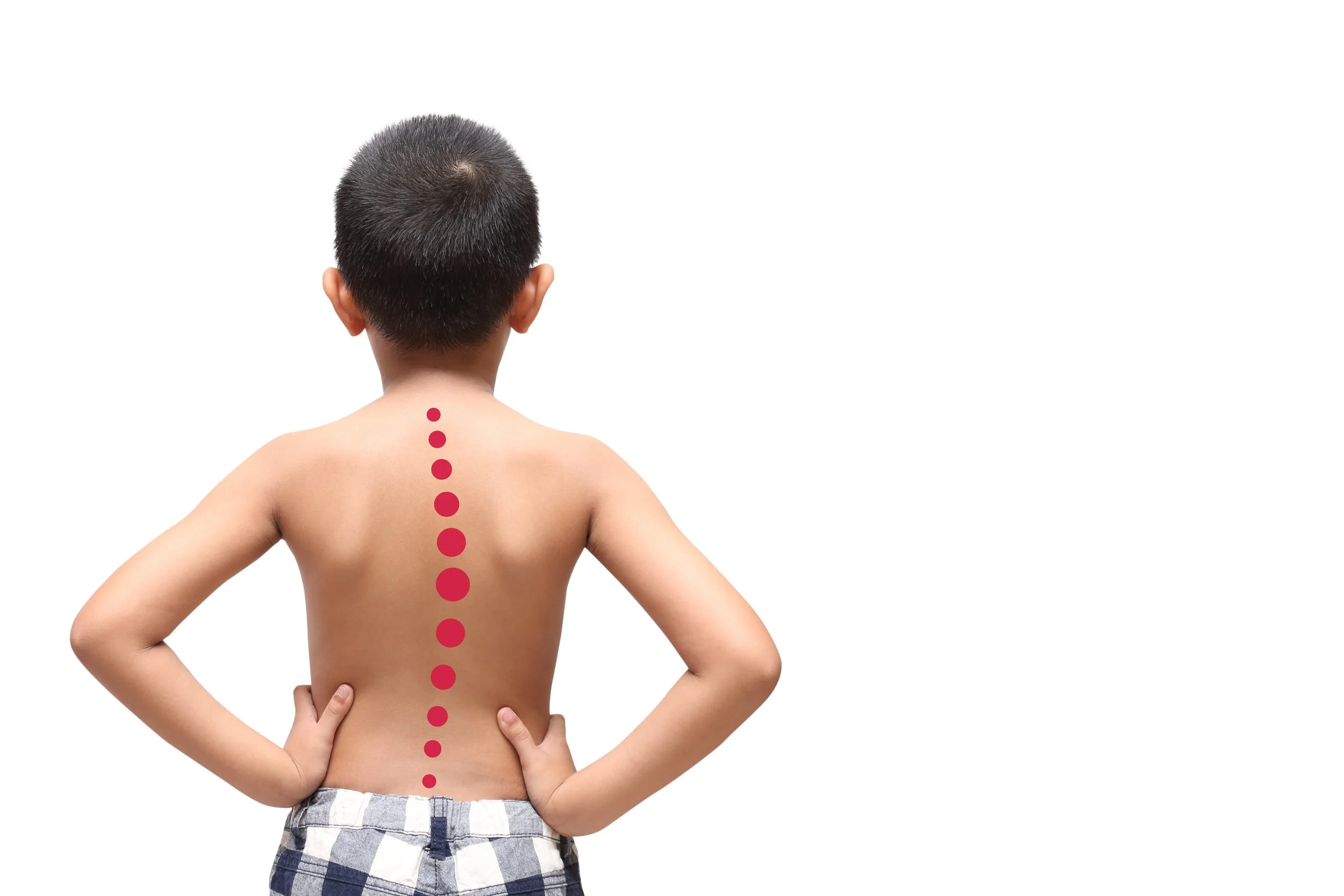Scoliosis Treatment
Considerations in the Treatment of Adolescent Idiopathic Scoliosis for the Physical Therapist
In the United States, adolescent scoliosis was aggressively screened in primary & secondary educational institutions then subsequently over-diagnosed due to the relatively high general population prevalence of 0.47% - 5.2%. The presence of scoliosis does not always necessitate professional intervention, in fact only 10% of scoliotic curves require medical intervention. Additionally, Schroth method certification is the gold standard for physiotherapy-specific scoliosis exercise (PSSE), and clinicians with Schroth background are not always readily available.
Scoliosis occurs at a higher rate in women than in men. For every 1 male with scoliosis, there are up to 3 females with scoliosis. And as the severity of curvature increases, the ratio increases, meaning women are more likely to suffer from a severe, life-altering curvature. 90% of adolescent thoracic curvatures are to the right. The general consensus of scoliosis severity grading is that a curvature ranging from 10-25 degrees is considered mild, 25-40 degrees moderate, and greater than 40 degrees as severe.
Bracing has been shown to halt or slow the progression of scoliosis in 74% of braced patients. However, braces have historically been poorly tolerated due to their size and comfort. Furthermore, the typical outpatient physical therapist may not have access to a reliable orthotist with knowledge on effective bracing. Therefore, the topic of bracing will not be addressed in this post.
The goal of this post is to distill publicly available information via the International Society on Scoliosis Orthopedic and Rehabilitation Treatment (SOSORT). SOSORT was established in response to a growing opposition against the ‘wait & see’ approach traditionally used for scoliotic curves under a 25 degree Cobb angle. With that said, research on conservative scoliosis management continues to lack the volume of rigorous randomized controlled clinical trials needed to make confident evidence-based claims. As such, an evidence-based approach for PSSE continues to be limited for its clinical effectiveness.
Scoliosis is most reversible if caught during an early stage of bone development (Risser Staging). With that said, most young adolescent scoliotic curves resolve without any intervention or never present with symptoms. For patients with completed bone development, adolescent idiopathic scoliosis may progress into adult idiopathic scoliosis.
Scoliosis in the later stages of bone development is not reversible. The cascade of events known as “the Stokes Vicious Cycle” leads to chronic asymmetrical vertebral body loading and forms wedge-shaped vertebrae that are gravity-dependent towards the direction of curvature. Therefore, the outpatient therapist should know that the likelihood of complete erasure of a curvature in an adolescent is unlikely. The goal of physical therapy at this stage is to prevent an increase in curvature.
Clearing & Screening for Scoliosis
In the outpatient physical therapy setting, therapists should be vigilant to screen for symptoms secondary to scoliosis. The Adam’s forward bend test is not unlike a lumbar flexion clearing test being performed for any number of lower extremity or lumbar diagnoses. Physical therapists should be sure to observe for rotational prominences in a forward flexed position. Scoliosis can also readily be observed during postural analysis. Common signs may include a lateral shift of the torso, upper extremities at different distances from the torso, and asymmetrically positioned scapulae. As alluded to above, the right thoracic curvature is the most common direction, meaning the observation of a left curvature is a red flag that should be explored further and referred for medical management.
Similarly, physical therapists should be aware of the conditions that may directly cause a scoliotic curvature summarized in the table below. Most likely to be seen in the outpatient setting is the leg length discrepancy. It can be inferred that any condition that may induce a leg length discrepancy may also cascade up the kinetic chain towards scoliosis (Legg-Calve-Perth, slipped capital femoral epiphysis, etc).
Scoliosis is rarely the diagnostic focus for the standard outpatient orthopedic, however, it can be addressed as an accessory to postural exercise and core stabilization training. The following list of interventions range are not ordered by any particular level of effectiveness. Schreiber et al. 2019 showed that regardless of any measurable changes in radiographic Cobb angle, patients with adolescent idiopathic scoliosis still perceived positive improvements after 6-months of Schroth-based intervention.
“One of my primary concerns when treating the spine is to prevent disc degeneration and also decrease the wear and tear on the facet joints.”
Physical Therapy Interventions
Active self-correction is the first intervention that ought to be weaved throughout working with a patient with scoliosis. The practice of active self-correction is the active practice of aligning the spine with frontal and transverse plane symmetry. Kinel et al. 2021 reveals that the practice of active self-correction is not intuitive. Extensive feedback and cueing should be used to facilitate long term retention of a symmetrical self-correction. The practice of active self-correction, once mastered in a static seated position, should then be performed in a diversity of postures and during dynamic exercises. See the below video for additional information on active self-correction.
The concave side of a curvature is chronically shortened and hypomobile. Conversely, a convexity is chronically overused, lengthened, and hypermobile. Physical therapists should focus range of motion, myofascial release, joint mobility and stretching interventions disproportionately on the side of the concavity. Strengthening, shortening and positioning the convexity in disadvantaged positions should be encouraged for the convexity. Consider also that muscles such as the iliopsoas and latissimus dorsii can elicit corrective forces on the spine with their contraction; for example, a right iliopsoas contraction will induce an infero-lateral force on the lumbar vertebrae. Pulmonary function is also a component of scoliosis that is often overlooked. Facilitation of rib expansion should be directed at the concavity while inhibitive techniques should be directed on the side of the rib prominence. Disadvantaged positioning is an effective means of blocking convex side rib expansion (ie. right side-lying to block right rib expansion). Active inspiration into the concavity can also be paired with active contraction of accessory muscles on the side of the convexity.
Finally, core stabilization ought to be a major component of long-term focus, especially in an actively corrected position. Patients should be encouraged to increase their endurance for core stabilization to decrease their risk of further exacerbating their curvature, and to build durability for use in a lifetime of activities. Physical therapists should feel at liberty to utilize the core strengthening approaches of their preference, always keeping in mind symmetry.
Plan of Care
There is no established guideline for dosage in physical therapy management of adolescent idiopathic scoliosis. Clinical trials which yielded successful, long-term results utilized an PSSE structure of three visits per week, for 6 weeks and follow-ups at 6, 12, and 24 weeks (Kuru et al. 2015). While this rate of visitation is unlikely to be achieved in a typical clinical setting, the clinical trial also showed that a home exercise program alone did not produce significant results in scoliosis severity.
“General movement is a necessity for daily living. The longer you can continue to move typically the higher the quality of life.”
Psychosocial Considerations
The presence of scoliosis has been correlated with low self-esteem and low participation in physical activity. Scoliosis can have a grossly observable impact on cosmesis that may influence a patient’s behavior with their family and peers. A discussion on the patient’s self-perception of their scoliosis may be indicated to get a sense of their attitude towards their condition.
AUTHOR:
CONTRIBUTORS:
Dr. Yung Lee, DO
EvergreenHealth Sport & Spine Physician, UW Adjunct Faculty
Dr. John Manning, MD
Evergreen Health Orthopedics & Sports Medicine
Dr. Addison Stone, MD
ProOrtho Orthopedic Spine Surgeon
Dr. Kenneth Nwosu, MD
NeoSpine Orthopedic Spine Surgeon
Ben Wobker, PT, MSPT, CSCS, CFSC, SFMA
Founder & Director LWPT
More Great Spine Related Articles
LWPT Spine Related Videos & Webinars
REFERENCES
Berdishevsky, H., Lebel, V.A., Bettany-Saltikov, J. et al. Physiotherapy scoliosis-specific exercises – a comprehensive review of seven major schools. Scoliosis 11, 20 (2016). https://doi.org/10.1186/s13013-016-0076-9
Kinel E, D'Amico M, Roncoletta P. 3D Quantitative Evaluation of Posture and Spine Proprioceptive Perception Through Instinctive Self-Correction Maneuver in Adolescent Idiopathic Scoliosis. Front Bioeng Biotechnol. 2021 Jun 1;9:663394. doi: 10.3389/fbioe.2021.663394. PMID: 34141701; PMCID: PMC8204188.
Konieczny MR, Senyurt H, Krauspe R. Epidemiology of adolescent idiopathic scoliosis. J Child Orthop. 2013 Feb;7(1):3-9. doi: 10.1007/s11832-012-0457-4. Epub 2012 Dec 11. PMID: 24432052; PMCID: PMC3566258.
Kuru T, Yeldan İ, Dereli EE, Özdinçler AR, Dikici F, Çolak İ. The efficacy of three-dimensional Schroth exercises in adolescent idiopathic scoliosis: a randomised controlled clinical trial. Clin Rehabil. 2016 Feb;30(2):181-90. doi: 10.1177/0269215515575745. Epub 2015 Mar 16. PMID: 25780260.
Reamy BV, Slakey JB. Adolescent idiopathic scoliosis: review and current concepts. Am Fam Physician. 2001 Jul 1;64(1):111-6. PMID: 11456428.
Romano M, Negrini A, Parzini S, Tavernaro M, Zaina F, Donzelli S, Negrini S. SEAS (Scientific Exercises Approach to Scoliosis): a modern and effective evidence based approach to physiotherapic specific scoliosis exercises. Scoliosis. 2015 Feb 5;10:3. doi: 10.1186/s13013-014-0027-2. PMID: 25729406; PMCID: PMC4344739.
Schreiber S, Parent EC, Hill DL, Hedden DM, Moreau MJ, Southon SC. Patients with adolescent idiopathic scoliosis perceive positive improvements regardless of change in the Cobb angle - Results from a randomized controlled trial comparing a 6-month Schroth intervention added to standard care and standard care alone. SOSORT 2018 Award winner. BMC Musculoskelet Disord. 2019 Jul 8;20(1):319. doi: 10.1186/s12891-019-2695-9. PMID: 31286903; PMCID: PMC6615154.
Schreiber S, Parent EC, Khodayari Moez E, Hedden DM, Hill DL, Moreau M, Lou E, Watkins EM, Southon SC. Schroth Physiotherapeutic Scoliosis-Specific Exercises Added to the Standard of Care Lead to Better Cobb Angle Outcomes in Adolescents with Idiopathic Scoliosis - an Assessor and Statistician Blinded Randomized Controlled Trial. PLoS One. 2016 Dec 29;11(12):e0168746. doi: 10.1371/journal.pone.0168746. PMID: 28033399; PMCID: PMC5198985.
Yagci G, Yakut Y. Core stabilization exercises versus scoliosis-specific exercises in moderate idiopathic scoliosis treatment. Prosthet Orthot Int. 2019 Jun;43(3):301-308. doi: 10.1177/0309364618820144. Epub 2019 Jan 10. PMID: 30628526.
Disclaimer: The information listed on this page is not to be used as a replacement for medical advice. If you have any questions or concerns regarding stretching, mobility, or strength training, please seek out an appointment with your physical therapist or primary care physician.




